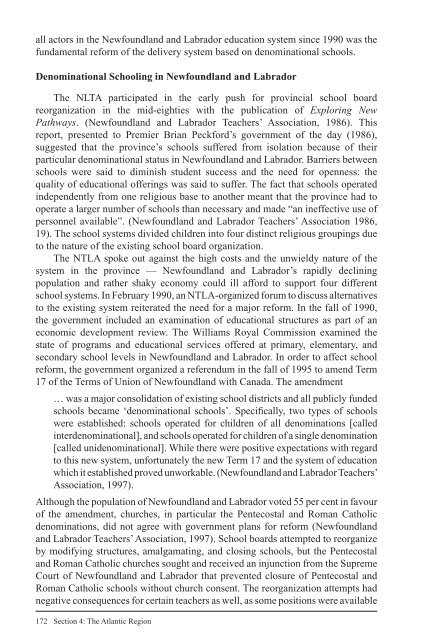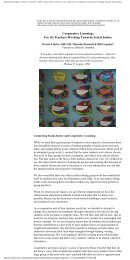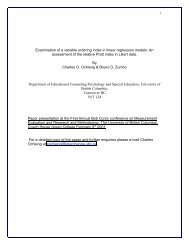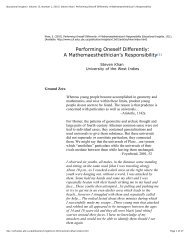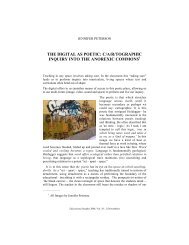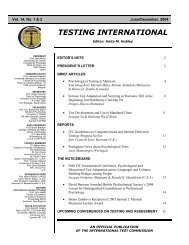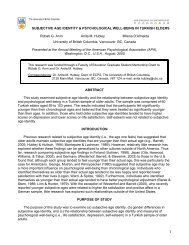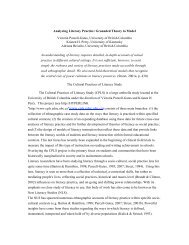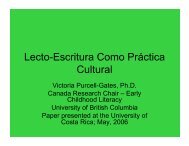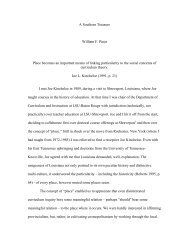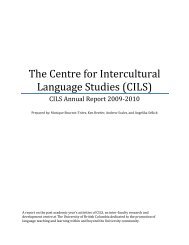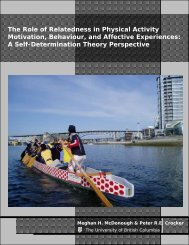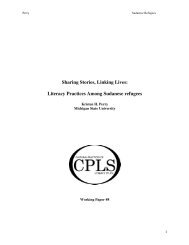The evolution of professionalism - Centre for Policy Studies in ...
The evolution of professionalism - Centre for Policy Studies in ...
The evolution of professionalism - Centre for Policy Studies in ...
Create successful ePaper yourself
Turn your PDF publications into a flip-book with our unique Google optimized e-Paper software.
all actors <strong>in</strong> the Newfoundland and Labrador education system s<strong>in</strong>ce 1990 was the<br />
fundamental re<strong>for</strong>m <strong>of</strong> the delivery system based on denom<strong>in</strong>ational schools.<br />
Denom<strong>in</strong>ational School<strong>in</strong>g <strong>in</strong> Newfoundland and Labrador<br />
<strong>The</strong> NLTA participated <strong>in</strong> the early push <strong>for</strong> prov<strong>in</strong>cial school board<br />
reorganization <strong>in</strong> the mid-eighties with the publication <strong>of</strong> Explor<strong>in</strong>g New<br />
Pathways. (Newfoundland and Labrador Teachers’ Association, 1986). This<br />
report, presented to Premier Brian Peck<strong>for</strong>d’s government <strong>of</strong> the day (1986),<br />
suggested that the prov<strong>in</strong>ce’s schools suffered from isolation because <strong>of</strong> their<br />
particular denom<strong>in</strong>ational status <strong>in</strong> Newfoundland and Labrador. Barriers between<br />
schools were said to dim<strong>in</strong>ish student success and the need <strong>for</strong> openness: the<br />
quality <strong>of</strong> educational <strong>of</strong>fer<strong>in</strong>gs was said to suffer. <strong>The</strong> fact that schools operated<br />
<strong>in</strong>dependently from one religious base to another meant that the prov<strong>in</strong>ce had to<br />
operate a larger number <strong>of</strong> schools than necessary and made “an <strong>in</strong>effective use <strong>of</strong><br />
personnel available”. (Newfoundland and Labrador Teachers’ Association 1986,<br />
19). <strong>The</strong> school systems divided children <strong>in</strong>to four dist<strong>in</strong>ct religious group<strong>in</strong>gs due<br />
to the nature <strong>of</strong> the exist<strong>in</strong>g school board organization.<br />
<strong>The</strong> NTLA spoke out aga<strong>in</strong>st the high costs and the unwieldy nature <strong>of</strong> the<br />
system <strong>in</strong> the prov<strong>in</strong>ce — Newfoundland and Labrador’s rapidly decl<strong>in</strong><strong>in</strong>g<br />
population and rather shaky economy could ill af<strong>for</strong>d to support four different<br />
school systems. In February 1990, an NTLA-organized <strong>for</strong>um to discuss alternatives<br />
to the exist<strong>in</strong>g system reiterated the need <strong>for</strong> a major re<strong>for</strong>m. In the fall <strong>of</strong> 1990,<br />
the government <strong>in</strong>cluded an exam<strong>in</strong>ation <strong>of</strong> educational structures as part <strong>of</strong> an<br />
economic development review. <strong>The</strong> Williams Royal Commission exam<strong>in</strong>ed the<br />
state <strong>of</strong> programs and educational services <strong>of</strong>fered at primary, elementary, and<br />
secondary school levels <strong>in</strong> Newfoundland and Labrador. In order to affect school<br />
re<strong>for</strong>m, the government organized a referendum <strong>in</strong> the fall <strong>of</strong> 1995 to amend Term<br />
17 <strong>of</strong> the Terms <strong>of</strong> Union <strong>of</strong> Newfoundland with Canada. <strong>The</strong> amendment<br />
… was a major consolidation <strong>of</strong> exist<strong>in</strong>g school districts and all publicly funded<br />
schools became ‘denom<strong>in</strong>ational schools’. Specifi cally, two types <strong>of</strong> schools<br />
were established: schools operated <strong>for</strong> children <strong>of</strong> all denom<strong>in</strong>ations [called<br />
<strong>in</strong>terdenom<strong>in</strong>ational], and schools operated <strong>for</strong> children <strong>of</strong> a s<strong>in</strong>gle denom<strong>in</strong>ation<br />
[called unidenom<strong>in</strong>ational]. While there were positive expectations with regard<br />
to this new system, un<strong>for</strong>tunately the new Term 17 and the system <strong>of</strong> education<br />
which it established proved unworkable. (Newfoundland and Labrador Teachers’<br />
Association, 1997).<br />
Although the population <strong>of</strong> Newfoundland and Labrador voted 55 per cent <strong>in</strong> favour<br />
<strong>of</strong> the amendment, churches, <strong>in</strong> particular the Pentecostal and Roman Catholic<br />
denom<strong>in</strong>ations, did not agree with government plans <strong>for</strong> re<strong>for</strong>m (Newfoundland<br />
and Labrador Teachers’ Association, 1997). School boards attempted to reorganize<br />
by modify<strong>in</strong>g structures, amalgamat<strong>in</strong>g, and clos<strong>in</strong>g schools, but the Pentecostal<br />
and Roman Catholic churches sought and received an <strong>in</strong>junction from the Supreme<br />
Court <strong>of</strong> Newfoundland and Labrador that prevented closure <strong>of</strong> Pentecostal and<br />
Roman Catholic schools without church consent. <strong>The</strong> reorganization attempts had<br />
negative consequences <strong>for</strong> certa<strong>in</strong> teachers as well, as some positions were available<br />
172 Section 4: <strong>The</strong> Atlantic Region


